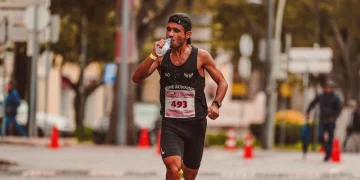The 80/20 rule is a popular training approach in running. According to Stephen Seiler’s research, this approach has helped many runners to achieve excellent results in various races: from the 5k to long-distance events and even triathlons. We will discuss the rule, how to use it, and when runners need to implement it in their training plans.
80 20 running became famous thanks to Matt Fitzgerald, a certified sports nutrition expert and writer about endurance sports, and David Warden, runner and coach. They combined Arthur Lydiard’s approach, and Dr. Stephen Seiler’s findings, adding their own observations and experience to determine that better race results can be achieved using slow training. Matt described all principles of such workouts in a book called “80/20 Endurance”.
What is 80 20 Running?
Simply put, you need to do 80% of your workouts at low intensity and 20% at medium and high intensity, except during training periods when it is better to increase or decrease the number of low-intensity workouts.
In addition, you should balance the medium and high-intensity workouts in your plan according to the race you’re training for.
As you see, the full wording of the rule is a little bit hard to understand, but the main thing to learn is the importance of low-intensity running speed and that the 80/20 split is not an axiom. It is just a benchmark to strive for if you want to recover and fully realize your potential in competition.
What Are the Benefits?
In a study by Seiler and a group of scientists, several runners with 10k bests of around 40 minutes were split into different groups and given a nine-week training plan with a split system training principle of either 50/50 or 80/20 between easy and hard training.
Both plans specified roughly 30 miles of running a week. On average, the 50/50 group (the kind of training many recreational runners do) improved their 10k time trial times by 3.6%. The 80/20 group improved by 5%, equivalent to 35 seconds.
In many books about 80/20 running, we can find benefits such as capillary network development, bone strengthening, increased maximum oxygen consumption, general endurance, improved running economy, increased metabolism, and use of fats as an energy source.
80/20 Running Summary
We gathered all the main facts you need to know from Matt Fitzgerald’s book, which can help you to improve split workouts in your training plan.
1. To Run Faster, You Need to Become Slower
Your training system must be consistent to ensure constant progress. We all understand that it is impossible to withstand daily hard running either psychologically or physiologically. But too many runners exhaust themselves with too intense workouts, causing overtraining.
It may seem ridiculous, but a runner gets faster by running slowly for most of the training plan. How is this possible? Modern studies of the world’s top runners have shown that they spend approximately 80% of their training time below the anaerobic threshold, that is, running at a conversational pace.
Thus, this research proves that runners who strictly limit the amount of hard work perform better than those constantly in a state of chronic fatigue.
2. Be Ready For the Leap of Faith
The secret to slow running is not new, but only a small percentage of runners understand it and use this training method for running. The reason is scientific skepticism and personal perception: slow running is unnatural for most runners. Blame it on the impulse to run every workout outside your comfort zone.
The problem is that the anaerobic threshold occurs almost immediately after transitioning from walking to running for many beginners and those who are overweight. They do not have much freedom to work in the low-intensity zone.
It is very hard to accept that slow running can make you faster, but those who do it get less tiring workouts and fantastic race results.
3. Perception Must Be Correct
Many runners have a habit of running above the anaerobic threshold because the body works more efficiently in this mode (in terms of metabolism and biomechanics). However, often the reason for fast running is also in our personal perception.
Runners reject a more comfortable pace in favor of critical velocity workouts. The reason is, in human psychology, when we have work to do, we want to finish it as soon as possible to stop suffering.
So, the fastest way to complete a workout is to treat it like a race and run as hard as possible. But the maximum effort comes with a certain amount of pain. So, what should we do?
The correct answer is to find a compromise between the desire to finish quickly, not suffer much, and perform at medium intensity, perceiving it as a light load.
4. Learn to Understand Intensity. Concentrate.
Most runners that think they are running slow are actually exceeding the recommended intensity. The cost of this mistake is permanent regression. How to solve the problem?
You need contrast (the ability to compare, to feel what low intensity is) to understand that you are overtraining and slowing down your progress. How to do it? Create a running analog of detox.
Mat Fitzgerald recommends giving yourself a week of very slow running to break the habit of running fast or at a moderate intensity every workout. Run slowly, without paying attention to your pulse rate or pace; feel and remember your sensations, and if it seems you are running slowly, slow down more.
After you have found an easy pace, try to focus your attention. During your first run on detox week, your mind will wander, which means you unconsciously run faster. So, don’t make the first workout long. It is better to run longer the next time.
Realizing that you used to run with some tension but didn’t notice it is the first step towards mastering the 80-20 rule.
Matt Fitzgerald divides all intensity into run training zones:
- Zone 1 requires the lowest intensity when you actively hold yourself back to stay on pace. This is your pace during a recovery jog after a hard workout.
- Zone 2 is broader and comfortable for doing easy runs. It depends on your well-being on a concrete day.
- Zone 3 is a zone of relaxed effort; sometimes, runners call it comfortably hard. You don’t strain, maintaining this pace.
- Zone 4 is harder; it looks like a half-marathon pace.
- Zone 5 is for the hard interval or hill workouts in interval training pace.
- There are also Zone X and Zone Y. They don’t have a number because they represent in-between paces, which Fitzgerald explains only as gaps between other zones. This prevents low-intensity efforts from bleeding into moderate-intensity and, on the upper end, forces athletes to commit to higher-intensity running.
Using these run training zone classifications and measured anaerobic thresholds, you can easily understand your pace for your 80/20 training plan.
5. Planning and Monitoring
If you want to build up a running endurance plan, it is easy. It consists of two components: planning and monitoring. Planning comes down to creating a training schedule: the plan should include approximately 80% of light training (below the anaerobic threshold) and 20% of training at medium and high intensity.
Monitoring is a measurement of intensity on every run, with heart rate monitoring being a more effective tool for tracking and correcting running slowly.
To determine what heart rate level corresponds to the concrete zone, you must determine the lactate threshold heart rate. You can do it either with a 30-minute test (warm-up and run with a heart rate monitor as hard as you can for half an hour. The average heart rate of the last 10 minutes will be the lactate threshold heart rate) or with a conversation test (start running with a heart rate monitor and gradually increase speed, trying every minute count aloud or say some phrase. Remember the last pace at which it was still comfortable to talk while running. The corresponding heart rate will be the lactate threshold heart rate). After, you can understand the intensity. It will be the following:
- Zone 1 = 65-85% LTHR;
- Zone 2 = 85-90% LTHR;
- Zone 3 = 90-95% LTHR;
- Zone 4 = 95-102% LTHR;
- Zone 5 = 102-110% LTHR.
6. Run Long to Become Faster
Arthur Lydiard came up with a universal and concise formula, “The secret to running fast is to run long.”
Endurance is the main limiter and the key to achieving the goal. So the training process of preparing for races should include the development of endurance. The runner increases aerobic capacity by increasing volume, so each new run becomes a little more intense while the respiratory threshold remains within the comfort zone.
7. Don’t Forget About High-Intensity Workouts
The key condition for the development of the aerobic system is stress. As long as you don’t put much more stress on your system than it does at rest, it won’t have to adapt and evolve.
Intense workouts develop aerobic performance faster than light ones. Namely, they stimulate rapid protein synthesis, resulting in more mitochondria in muscle cells, which allows the body to supply oxygen to muscles more efficiently and faster. This is the 20% that is reserved for heavy loads.
8. Fatigue Resistance
It is possible to train fatigue tolerance. Once runners discover that they can handle more than they thought, their perception of the load shifts. It is low-intensity and volume training that develops this ability. Long-term, low-intensity workouts tire the brain more than intense, short-term workouts.
The stronger the zones responsible for the emotional components of the load become, the slower the feeling of fatigue will appear in the runner during the competition.
9. Technique and Self-Optimization
Having good technique means having an efficient running stride. Still, forced changes to the natural running technique almost always worsen the results instead of improving them.
Many great runners who do not have perfect technique have a quality called “relaxed smoothness and ease of movement.” It means that the more relaxed the runner’s stride, the less tired they will be.
Low-intensity workouts are the best way to learn relaxed running, the true essence of running technique.
Wrap Up
You need to use an 80/20 training system for better endurance and increased race results. It will help you to achieve maximum running intensity and improve your running technique.
To create your personal 80 20 training plan for free you can use our article and materials from Arthur Lyniard’s lecture.






